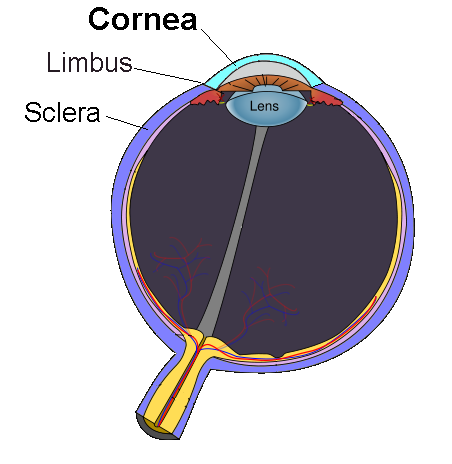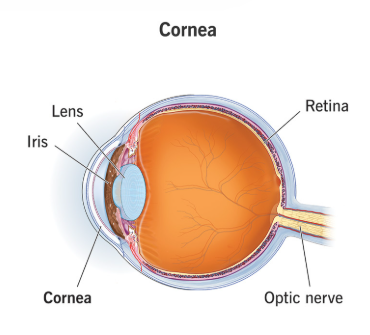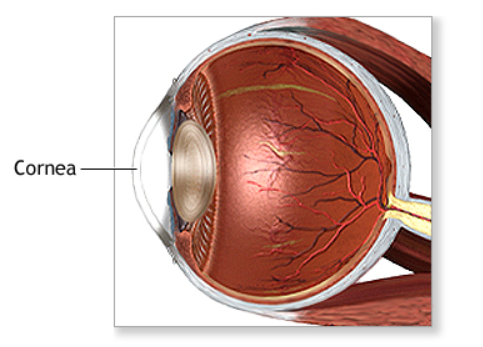Corneal problems are conditions that damage or affect the clarity, shape, or function of the cornea, leading to symptoms such as eye pain, redness, blurred vision, light sensitivity, or foreign body sensation.

types of corneal problems:
1. Infectious Corneal Problems
- Bacterial keratitis – infection often linked to contact lens use or trauma
- Viral keratitis – especially herpes simplex and herpes zoster (shingles)
- Fungal keratitis – after trauma with plant material or in immunocompromised patients
- Parasitic keratitis – Acanthamoeba infection, usually from contaminated contact lenses
2. Traumatic / Mechanical Problems
- Corneal abrasions – scratches from fingernails, dust, or foreign bodies
- Corneal lacerations – deep cuts from sharp objects
- Chemical burns – acid or alkali exposure
- Foreign bodies – particles embedded in the cornea
3. Degenerative / Structural Problems
- Keratoconus – progressive thinning and cone-shaped bulging of the cornea
- Pellucid marginal degeneration – thinning of the inferior cornea
- Corneal dystrophies – inherited disorders like Fuchs’ dystrophy or lattice dystrophy
4. Inflammatory / Autoimmune Problems
- Keratitis (non-infectious) – due to inflammation rather than microbes
- Peripheral ulcerative keratitis – associated with autoimmune diseases (e.g., rheumatoid arthritis)
5. Metabolic / Nutritional Problems
- Vitamin A deficiency – causes xerophthalmia, corneal ulceration, and scarring
- Systemic metabolic disorders – e.g., Wilson’s disease (copper deposits causing Kayser-Fleischer ring)
6. Iatrogenic / Post-Surgical Problems
- Post-LASIK ectasia – corneal weakening after refractive surgery
- Graft rejection – after corneal transplantation
The causes of corneal problems:
1. Infectious Causes
- Bacterial:Staphylococcus aureus, Pseudomonas aeruginosa
- Often associated with contact lens use or trauma
- Viral: Herpes simplex virus (HSV), Varicella-zoster virus (VZV)
- Fungal:Fusarium, Aspergillus, Candida
- Often after agricultural trauma or immunosuppression
- Parasitic:Acanthamoeba
- Usually in contact lens wearers exposed to contaminated water
2. Traumatic / Mechanical Causes
- Corneal abrasions or lacerations from fingernails, dust, metal, or plant material
- Chemical burns (acid or alkali exposure)
- Foreign bodies embedded in the cornea
- Contact lens overuse or poor hygiene
3. Degenerative / Structural Causes
- Keratoconus: thinning and bulging of the cornea (idiopathic, sometimes genetic)
- Corneal dystrophies: inherited disorders causing opacity or deposits (e.g., Fuchs’ endothelial dystrophy)
- Pellucid marginal degeneration: peripheral thinning of the cornea
4. Inflammatory / Autoimmune Causes
- Keratitis: inflammation due to infection or autoimmune disease
- Peripheral ulcerative keratitis: associated with rheumatoid arthritis or other connective tissue disorders
5. Systemic / Metabolic Causes
- Vitamin A deficiency: can cause xerophthalmia and corneal ulceration
- Liver or metabolic disorders: may cause corneal deposits (e.g., Wilson’s disease—Kayser-Fleischer rings)
6. Iatrogenic / Post-Surgical Causes
- Complications after eye surgery (e.g., LASIK, cataract surgery)
- Drug toxicity: long-term topical medications, e.g., glaucoma drops
The symptoms of corneal problems:
1. Common Symptoms
- Eye pain or discomfort – can range from mild irritation to severe pain
- Redness (conjunctival injection) – due to inflammation or infection
- Tearing (epiphora) – reflex tearing from irritation
- Photophobia (light sensitivity) – common in infections or ulcers
- Blurred or decreased vision – caused by corneal opacity, scarring, or irregular curvature
- Foreign body sensation – feeling that something is in the eye
- Swelling of the eyelids – may accompany infection or inflammation
2. Symptoms by Specific Corneal Condition
| Condition | Key Symptoms |
|---|---|
| Corneal abrasion | Sharp pain, tearing, redness, foreign body sensation |
| Keratitis (infection) | Pain, redness, photophobia, discharge, blurred vision |
| Corneal ulcer | Severe pain, cloudy/white spot on cornea, tearing, sensitivity to light |
| Keratoconus | Progressive blurred vision, ghosting or double images, light sensitivity |
| Fuchs’ endothelial dystrophy | Gradual blurry vision, especially in the morning, glare |
| Chemical burn | Severe pain, redness, tearing, swelling, possible vision loss |
| Dry eye / keratoconjunctivitis sicca | Burning, itching, gritty sensation, redness, fluctuating vision |
3. Red Flag Symptoms
- Sudden severe pain
- Marked vision loss
- Corneal opacity or white spot
- Severe photophobia
- Discharge with redness

Treatment of corneal problems:
1. Infectious Corneal Problems
- Bacterial keratitis/ulcers: Use topical antibiotics (start broad-spectrum, adjust based on culture). Severe cases may need oral antibiotics.
- Viral keratitis (e.g., HSV): Treat with topical or oral antivirals such as acyclovir or ganciclovir.
- Fungal keratitis: Apply topical antifungals (like natamycin or voriconazole); oral antifungals may be needed for deep infections.
- Parasitic (Acanthamoeba) keratitis: Long-term treatment with topical anti-amoebic agents, e.g., polyhexamethylene biguanide.
2. Traumatic or Mechanical Corneal Problems
- Corneal abrasion: Lubricating eye drops or ointment, antibiotic prophylaxis to prevent infection, and pain management.
- Chemical burns: Immediate and copious eye irrigation, followed by topical antibiotics and anti-inflammatory drops; surgery may be needed for severe cases.
- Foreign bodies: Removal by an ophthalmologist, followed by antibiotic prophylaxis and supportive care.
3. Degenerative or Structural Corneal Problems
- Keratoconus: Correct vision with glasses or rigid contact lenses; corneal cross-linking can slow progression; severe cases may require corneal transplant.
- Corneal dystrophies: Symptomatic treatment with lubricants or hypertonic saline; severe cases may need surgical options like lamellar or penetrating keratoplasty.
4. Inflammatory or Autoimmune Corneal Problems
- Use topical corticosteroids carefully under supervision.
- Immunomodulatory therapy may be needed for autoimmune-related keratitis.
- Lubricating eye drops help with symptoms and healing.
5. General Supportive Measures
- Keep eyes lubricated to prevent dryness.
- Avoid wearing contact lenses during active corneal disease.
- Use protective eyewear to prevent trauma.
- Seek prompt ophthalmologic care for any worsening symptoms.
